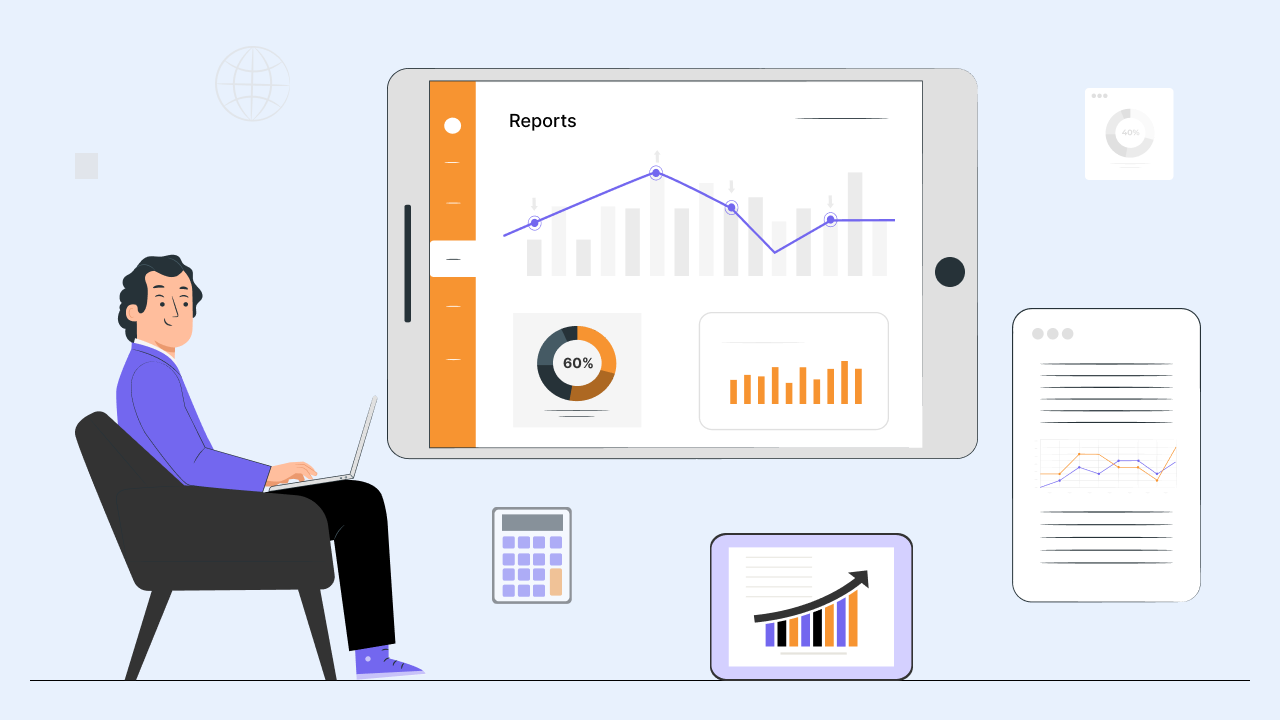Everything You Need To Know About Financial Reporting

We all have heard the headline on a business news channel that a company made X percentage of profits. Haven’t you? Have you ever wondered where this data comes from? Naah? Don’t worry, we are here to help you. Publicly listed companies are liable to release financial reports to inform their investors about the financial health of their business.
Whether or not a business is publicly listed, founders, directors, CFOs, and angel investors need to study the financials of a company to decide on a further course of action. Thus, a business needs to generate financial reports.
In this blog, we will understand the significance of financial reports and how online accounting software in India can help to generate the same.
Types Of Financial Reports

Following are the various types of financial reports that you should generate from financial report software and study them thoroughly to make your business more profitable:
Income Statement
Sometimes an income statement is referred to as a P & L statement or a Profit and Loss statement. This statement dictates the performance of revenue, net income, expenses, and earnings per capital share if the company is listed on the stock exchange. The following are the key elements of the income statement:
- Net and gross revenues – It shows the total sales revenue and the balance revenue after deducting costs.
- Operating revenue – It refers to the revenue generated by a company from its primary business.
- Non-operating revenue – It is generated from an additional income source of a company, such as capital gains, royalty payments, investment returns, or accrued interest.
- Primary expenses – These account for raw material costs, depreciation, and administrative costs.
- Secondary expenses – It includes loan interest, debt repayment, asset loss, and capital loss.
Balance sheet
The balance sheet dictates the total assets, liabilities, and equity in possession. Generally, a business assesses a balance sheet on a quarterly basis and shares it publicly if the company is listed on the stock exchange. It gives insight into a company’s current assets, liquidity, and coverage.
One can assess the overall financial health of a company by assessing the balance sheet. Whether you seek funds from banks, NBFCs, or private companies, they will ask you to submit a balance sheet. Hence, you must generate a monthly/quarterly balance sheet to track the progress of your business. Following are the key segments of a balanced sheet:
- Current liabilities – These includes long-term and short-term liabilities, tax, accounts payables, salaries and wages, and dividends.
- Current assets – It includes accounts receivable, inventory, fixed assets, and prepaid expenses
- Liquid assets – It includes cash, treasury bills, certificates of deposit, and short-term securities
- Shareholders/promoters/owner equity values – It includes receivable dividends, retained earnings and capital gains, and stocks.
Cash Flow Statement
A cash flow statement is a financial statement that records the movement of cash and its equivalents in and out of a business. This statement illustrates how well a company manages its cash, highlighting revenue generated, operating expenses, and debt repayment.
It shows the performance of business operations and investments. Thus, accurate cash flow statements are important to understand the efficiency of business operations. Rely on Munim – online accounting software in India to generate cash flow statements accurately, no more waiting for month-end or quarter-end as it generates statements with real-time data. The following are the important elements of the cash flow statement:
- Operational activities – It includes accounts receivable and payable, cash receipts, tax, inventories, salaries, and wages.
- Financial activities – It comprises dividends, debt repayment, stock repayments and issuance, and investments from investors
- Primary investment activities – These covers the inflow and outflow of investment earnings, asset sales, payments from mergers or acquisitions, and loans.
- Secondary investment activities – Encompass fixed-asset purchases like equipment or office space, or manufacturing facilities.
Benefits Of Assessing Financial Reports

Financial reporting serves multiple purposes other than compliance and legal requirements. The following are the benefits of financial reporting:
Assessing Trends
Financial reports of a company help them track potential opportunities and foresight the risk of enabling you to prevent roadblocks to business growth.
Cash Flow Management
Cash flow management is keeping track of the money flowing into your business and going out to pay bills, salaries, and inventories. When a company manages cash perfectly, cash is left on hand in the form of profits after paying all the bills.
Working Capital Management
Financial reporting gives information about the requirement of working capital to meet the liabilities. It also helps in managing debt, bill payments, and capacity utilization.
Assess Inventories & Assets
The balance sheet is a component of a financial report where assets and inventories are mentioned. From analyzing the balance sheet along with the sales forecast, one can tell if inventories are enough or not. A company should not have more inventories than required because it creates dead investment and storage issues. On the other hand, keeping inventories less than required will lead to losing customers.
Operation Management
The apex body of a company relies on financial reports to measure the output of business operations. As per the data furnished in the report, they take decisions to make the company’s operation more efficient and effective.
Over To You
So this was all about financial reporting that you need to know. If you are generating financial reports manually, then let me help you with a financial reporting tool. Munim being online accounting software in India can generate insightful reports with real-time data in just a few clicks. Not only that, it can make your e-invoicing process easy.
For more information, you can schedule a free demo.
Frequently Asked Questions On Financial Reporting
Q. What is financial reporting?
Ans.
Financial reporting is a process of documenting and conveying all the financial transactions to the apex management team and the shareholders of a company.
Q. What are the different elements of financial reporting?
Ans.
Following are the 5 different elements of financial reporting:
- Assets
- Liabilities
- Income
- Expense
- Equity
Q. What are the types of financial reports?
Ans.
There are different types of financial statements a company usually drafts, which are: income statements, balance sheets, and cash flow statements.
Q. What are the 4 A’s of financial management of a company?
4 A’s financial management is the pillar of any good financial planning of a company which is as follows:
- Analysis
- Adjustment
- Accounting
- Allocation





